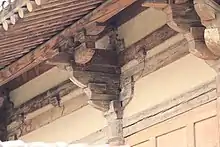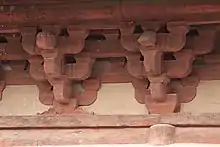驼峰 (建筑)
驼峰,日本稱為蟇股,为東亞传统建筑中于上下梁枋间配合斗拱起支承托垫作用的墩木,能适当地将结点的荷载匀布于梁上,因通常做成骆驼背峰式样故名。驼峰有全驼峰和半驼峰两种做法,前者多见,其式样在元代及以前有鹰嘴式、掐瓣式、毡笠(笠帽)式和梯形式等,明清时多为云卷式或荷墩式,此外清代也用柁墩替代驼峰[1][2]。

清代浮雕如意龙头纹驼峰,绩溪博物馆藏。

唐代建筑南禅寺柱头斗栱上方正常视角中被遮住的驼峰-皿板-斗结构以及补间隐刻驼峰,示驼峰的早期形态。

金代建筑支撑补间铺作的驼峰。

安徽黟县南屏村叶氏支祠,示驼峰的应用。
参考文献
- 北京市文物研究所. . 北京: 中国书店. 1992.
- 郑天挺,吴泽,杨志玖,翁独健,蔡美彪,李学勤等. . 上海: 上海辞书出版社. 2000.
This article is issued from Wikipedia. The text is licensed under Creative Commons - Attribution - Sharealike. Additional terms may apply for the media files.

